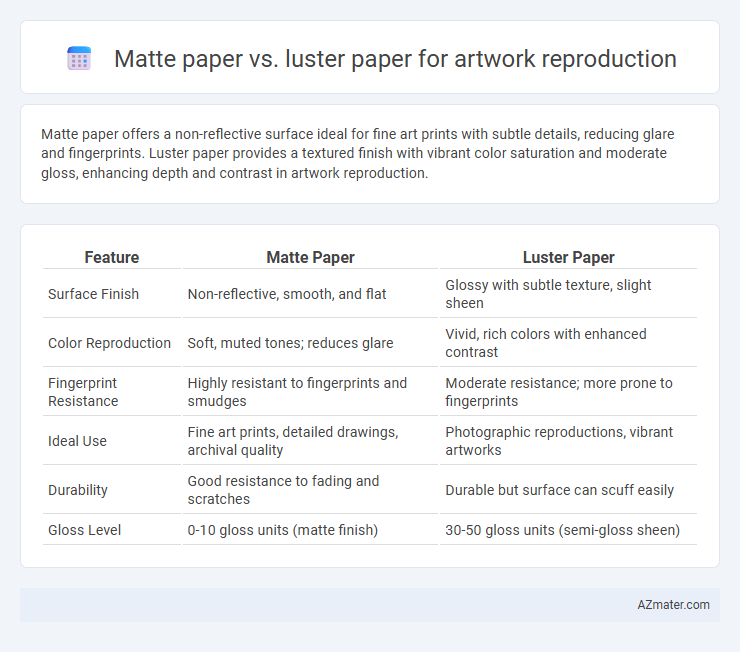Matte paper offers a non-reflective surface ideal for fine art prints with subtle details, reducing glare and fingerprints. Luster paper provides a textured finish with vibrant color saturation and moderate gloss, enhancing depth and contrast in artwork reproduction.
Table of Comparison
| Feature | Matte Paper | Luster Paper |
|---|---|---|
| Surface Finish | Non-reflective, smooth, and flat | Glossy with subtle texture, slight sheen |
| Color Reproduction | Soft, muted tones; reduces glare | Vivid, rich colors with enhanced contrast |
| Fingerprint Resistance | Highly resistant to fingerprints and smudges | Moderate resistance; more prone to fingerprints |
| Ideal Use | Fine art prints, detailed drawings, archival quality | Photographic reproductions, vibrant artworks |
| Durability | Good resistance to fading and scratches | Durable but surface can scuff easily |
| Gloss Level | 0-10 gloss units (matte finish) | 30-50 gloss units (semi-gloss sheen) |
Introduction to Matte and Luster Paper
Matte paper features a non-reflective, smooth surface ideal for artwork reproduction that emphasizes texture and subtle color gradients without glare. Luster paper offers a semi-gloss finish with a slightly textured surface, enhancing color vibrancy and providing rich contrast while reducing fingerprints and glare compared to glossy options. Choosing between matte and luster paper depends on the desired visual impact and how the artwork's details and colors are best presented.
Understanding Paper Finishes in Art Reproduction
Matte paper offers a non-reflective, smooth finish that enhances fine details and provides a subtle color palette, ideal for artworks requiring a soft, muted look. Luster paper combines slight gloss with texture, delivering vibrant colors and deep contrast while reducing glare, making it perfect for high-impact, detailed reproductions. Selecting the right paper finish depends on the desired visual effect, artwork style, and lighting conditions to optimize color accuracy and image depth in art reproduction.
Visual Differences: Matte vs Luster Paper
Matte paper offers a non-reflective surface that reduces glare and enhances subtle color tones, making it ideal for detailed artwork with soft gradients. Luster paper features a semi-gloss finish that intensifies colors and contrast, providing vibrant visuals with a textured feel that adds depth to photographs and prints. The visual difference lies in matte's muted, elegant appearance versus luster's vivid, sharp imagery, influencing the viewer's perception of artwork reproduction.
Color Vibrancy and Tonal Range Comparison
Matte paper produces artwork reproductions with muted colors and a softer finish, resulting in lower color vibrancy compared to luster paper. Luster paper offers enhanced color saturation and a broader tonal range due to its semi-gloss surface, which better preserves highlights and shadows. The choice between matte and luster impacts the visual depth and overall intensity of reproduced artwork colors.
Surface Texture and Artistic Detail
Matte paper offers a smooth, non-reflective surface that enhances fine artistic detail without glare, making it ideal for subtle textures and intricate line work in artwork reproduction. Luster paper features a slightly textured surface with a semi-gloss finish that boosts color vibrancy and depth while maintaining sharp detail, perfect for reproductions requiring rich tones and dynamic contrast. Choosing between matte and luster paper depends on the desired balance between surface texture and the prominence of artistic detail in the final print.
Glare and Viewing Experience
Matte paper minimizes glare, providing a smooth, non-reflective surface ideal for viewing artwork under varied lighting conditions without distraction. Luster paper offers a subtle sheen that enhances color vibrancy and depth while reducing glare compared to glossy finishes, creating a balanced viewing experience with slight texture. Choosing between matte and luster paper impacts the artwork's visual clarity and audience engagement depending on the lighting environment and desired image presentation.
Durability and Longevity
Matte paper offers excellent durability and resists fingerprints and glare, making it ideal for long-term artwork reproduction where preservation is crucial. Luster paper provides a protective coating that enhances color vibrancy while offering moderate resistance to scratches and fading over time. Both options contribute to the longevity of printed art, but matte paper generally outperforms in preventing surface wear and extending lifespan under varied display conditions.
Framing and Presentation Considerations
Matte paper minimizes glare and reflections, making it ideal for artwork reproduction when displayed under bright lighting or behind glass, enhancing visual clarity without distracting shine. Luster paper offers a subtle sheen that enriches color depth and contrast, providing a vibrant presentation but may require non-glass framing or anti-reflective glazing to prevent glare. Choosing between matte and luster paper depends on the artwork's color intensity and the lighting conditions, ensuring optimal framing and presentation for long-lasting visual appeal.
Cost Differences Between Matte and Luster Paper
Matte paper typically costs less than luster paper due to its simpler coating process and lower demand in high-end photo printing. Luster paper, favored for its vibrant color reproduction and slight gloss, generally commands a higher price reflecting its premium quality and durability. When budgeting for artwork reproduction, choosing matte paper can reduce costs significantly while still maintaining satisfactory visual appeal.
Choosing the Right Paper for Your Artwork Reproduction
Matte paper offers a smooth, non-reflective surface ideal for detailed artwork reproduction, enhancing color depth and texture without glare, making it suitable for vibrant or delicate pieces. Luster paper features a subtle sheen combining the benefits of glossy and matte finishes, providing rich color saturation and sharp image clarity while reducing fingerprints and glare, perfect for photographic artwork. Selecting between matte and luster paper depends on the artwork's visual characteristics, desired finish, and display environment to ensure accurate color reproduction and longevity.

Infographic: Matte paper vs Luster paper for Artwork reproduction
 azmater.com
azmater.com